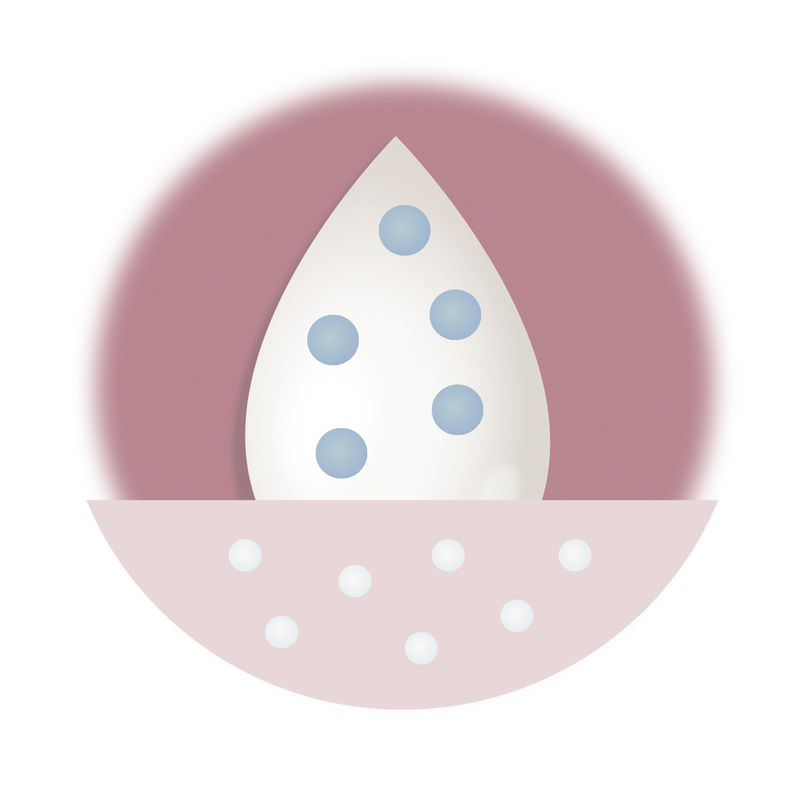
Milk contains different types of proteins; the major ones are casein and whey. These types of proteins can behave differently in little tummies (1).
There are two types of caseins that can especially make a difference: A1 Beta-casein and Alpha S1-casein. These both have been shown to cause inflammation and digestive upset. A1 can be found in Cow milk where Goat milk only contains the A2 type beta-casein (2).
Lower amounts of Alpha S1-casein can produce a softer curd in the stomach, enabling it to be broken down more comfortably. Goat milk can have as low as 5.6% vs 38% in Cow milk (3).
Did you know that Goat milk fat globules are 5-10 smaller than cow milk fat globules? The size of a milk fat globule can make a difference to its digestibility. If smaller, it is broken down more readily by digestive enzymes (4).
Medium Chain Fatty Acids (MCTs)Milk fat globules contain different types of fats which are digested differently in little tummies. MCTs are easily broken down and absorbed faster compared to other types of fats. Because they are broken down so quickly, they become an immediate energy source - ready to go! Goat Milk contains higher amounts of MCTs compared to Cow Milk (5).


Goat milk contains a naturally higher level of prebiotic oligosaccharides. Prebiotics provide food to the beneficial gut bacteria, maintaining overall health and wellbeing. The presence of oligosaccharides in Goat milk is at least 5x times higher than Cow milk (6).
There are many different oligosaccharides, but one in particular, 2’Fucosyllactose (2’FL), is a particularly important food to the beneficial gut bacteria, it also aids in preventing the growth of nasty pathogens in the gut. Goat milk naturally contains 2’FL, where Cow milk does not (7).
Another oligosaccharide found in Goat milk is GOS or 3-galactosyllactose, which is a natural GOS type of prebiotic sugar. GOS is known to reduce the adhesion of nasties in the gut and enhance the growth of the beneficial bacteria, especially lactobacillus and bifidobacteria, which is the predominant bacteria in little digestive systems (8).
1. Davoodi et al. (2016). Iran J Pharm Res
2. Guantario et al. (2020). Nutrients.
Brooke-Taylor et al (2017) Adv.
Tomotake et al. (2006) Biosci Biotechnol Biochem.
3. Park (2007). CAB Reviews: Perspectives in Agriculture, Veterinary Science, Nutrition and Natural Resources
Tomotake et al. (2006) Biosci Biotechnol Biochem
4. Attaie et al. (2000) J Dairy Science
Arora, et al (2013). Int J Eng Sci Invention
5. Arora, et al (2013). Int J Eng Sci Invention
Lad et al. (2017). Int J Curr. Microbiol. App. Sci
Los-Rycharska et al. (2016) Prz Gastroenterol
6. Meyrand et al. (2013) Small Rumin Res
J Slavin (2013). Nutrients
7. Oliveira et al. (2015) Int J Dairy Tech
8. Meyrand et al. (2013) Small Rumin Res
Leong et al. (2019) Br J Nutr
Asakuma et al. (2011). J Bio. Chem
Full references available upon request.
After much thought and consideration, we made the tough call to discontinue our Baby Steps Stage 4 Goat Junior Milk Drink, and we are now officially out of stock.
We know that there are a lot of little ones out there who have come to love our Stage 4 Goat Junior Milk Drink, but we hope that you can take comfort in knowing that our Stage 3 Goat Toddler Milk Drink can be offered in its place. It is made to the same nutritional level as our Stage 4 Goat Junior Milk Drink—just without the natural vanilla flavour or lutein.
We thank you for the continued support you have shown us in purchasing our Stage 4 Goat Junior Milk Drink, and please feel free to reach out to us if you have any questions or feedback at info@babystepsnz.com.
Close